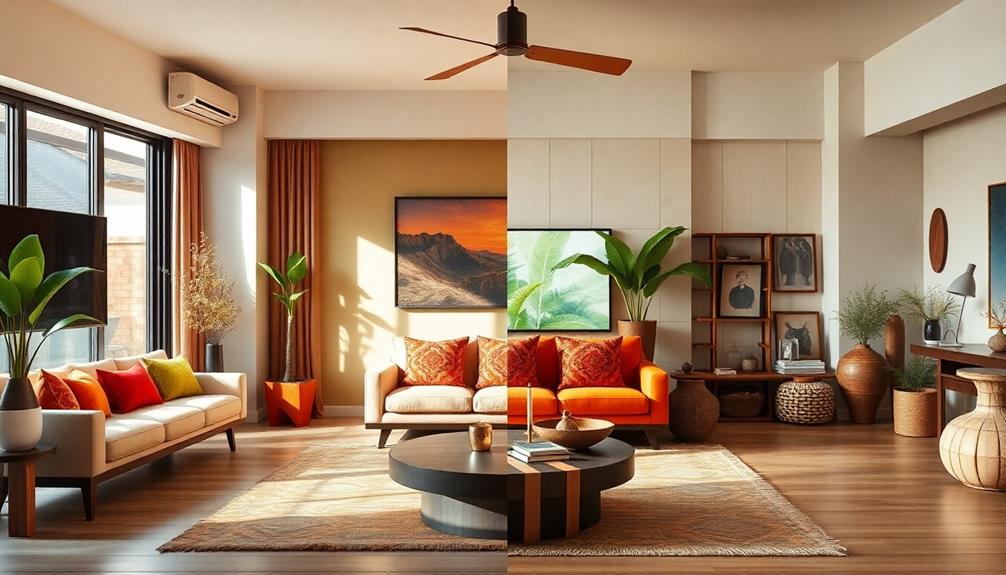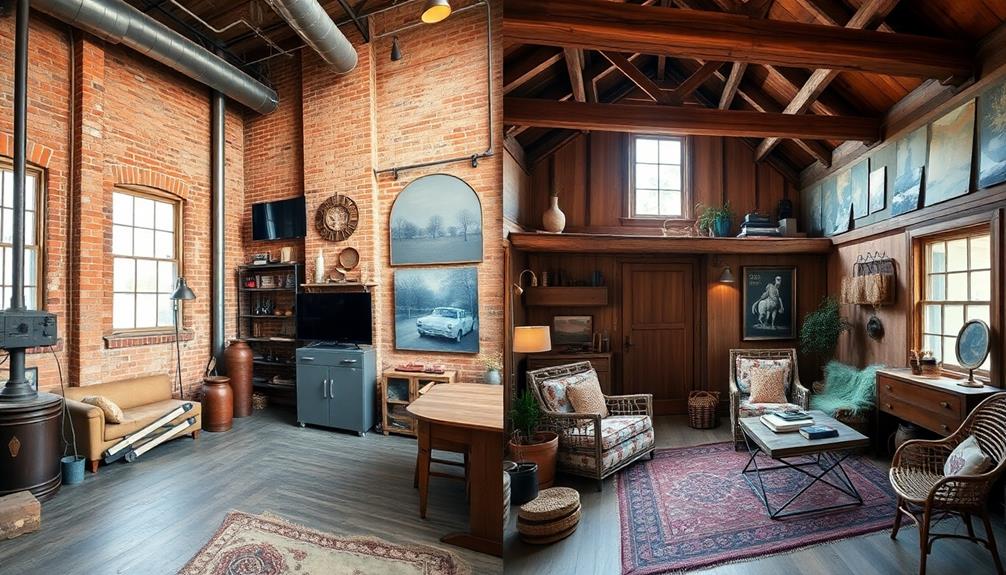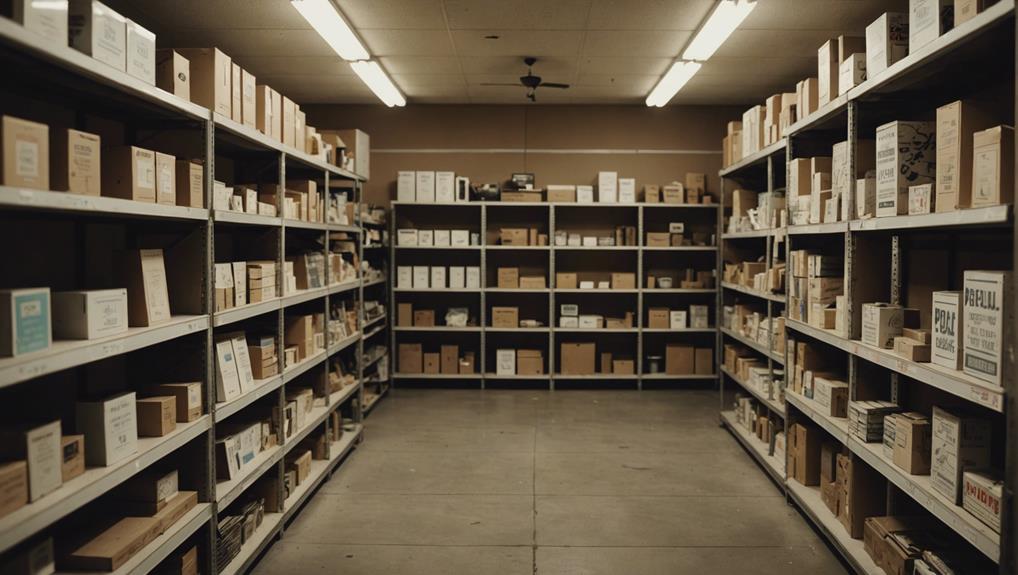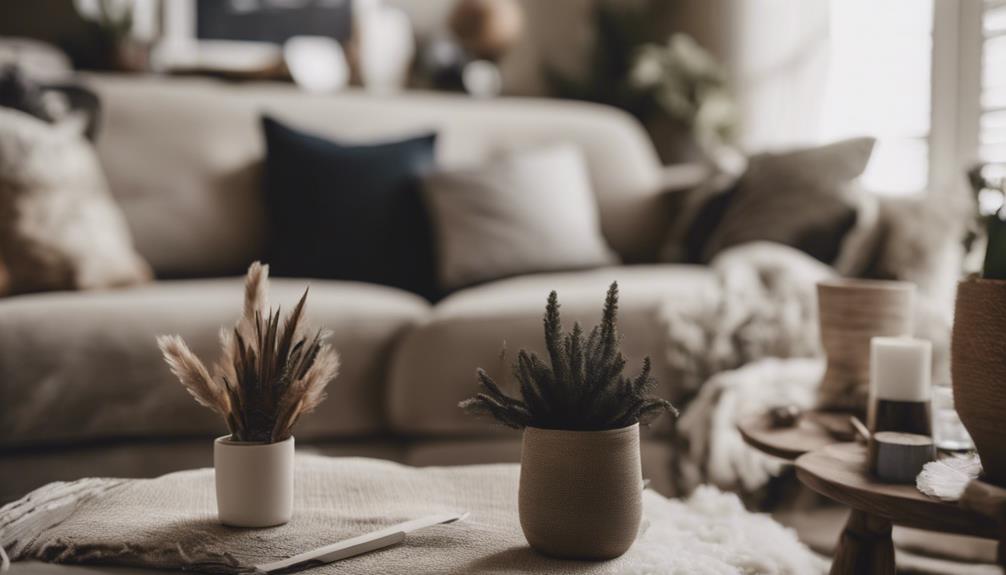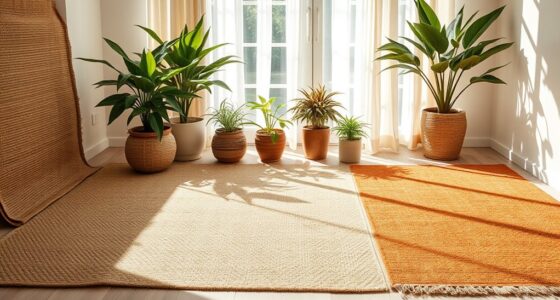When you explore Indonesian interior styles, you'll notice a sharp contrast between urban and rural designs. Urban interiors lean toward modern materials like cement and glass, emphasizing functionality and minimalist aesthetics. In contrast, rural spaces cherish traditional craftsmanship and local materials, promoting community through inviting atmospheres. Vibrant textiles and handcrafted furniture thrive in rural homes, while urban designs sometimes lack that cultural richness. Both settings are gradually adopting sustainable practices, but the emphasis remains distinct. If you're curious about how these styles affect community engagement and sustainability, there's plenty more to uncover.
Key Takeaways
- Urban interiors emphasize modern materials and minimalist aesthetics, focusing on functionality and efficiency, often at the expense of sustainability.
- Rural interiors celebrate traditional craftsmanship, utilizing local materials and vibrant textiles that promote community connections and cultural heritage.
- Urban designs prioritize space optimization with multifunctional furniture, while rural designs also embrace multifunctionality but with a focus on handcrafted items.
- Sustainable practices are more common in rural settings, using local materials, while urban designs are increasingly integrating eco-friendly options.
- Community involvement in rural areas fosters collaboration with local artisans, enhancing customization and cultural reflection in designs compared to urban settings.
Cultural Influences on Design
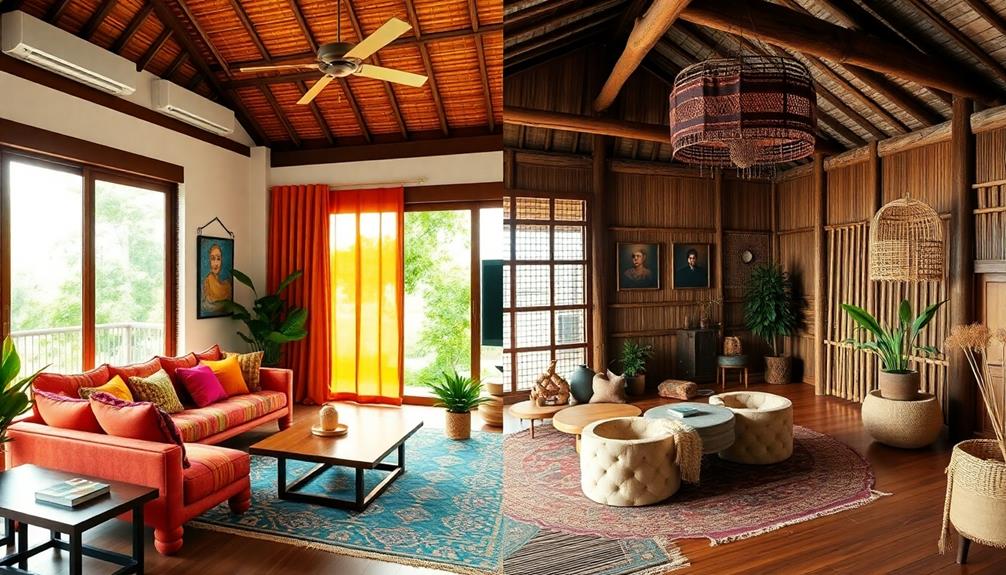
Cultural influences play an essential role in shaping interior design across Indonesia, with distinct differences between urban and rural styles.
In urban areas, you'll notice that interior designs often lean toward modern materials and minimalist aesthetics. This reflects the fast-paced lifestyle and convenience-oriented preferences of city dwellers.
However, when you step into rural settings, the emphasis shifts dramatically. Here, traditional craftsmanship and local materials take center stage, resonating with the cultural heritage of the community. For instance, the use of Indonesian decorative pillows adds vibrant colors and intricate patterns that enhance living spaces, showcasing the rich cultural identity.
In rural interiors, the integration of local cultural elements is more pronounced. Traditional rituals and skills not only influence the design but also foster a deeper connection to the past.
You'll see indigenous materials, such as woven bamboo matting, used to create spaces that honor cultural significance. In contrast, urban designs may prioritize functionality over cultural representation, blending contemporary Indonesian styles with international influences.
While urban trends often focus on aesthetics and modernity, rural designs emphasize self-sustainability and community engagement.
Ultimately, understanding these cultural influences helps you appreciate the unique identity of each setting, revealing how much heritage impacts design choices across Indonesia.
Characteristics of Urban Interiors
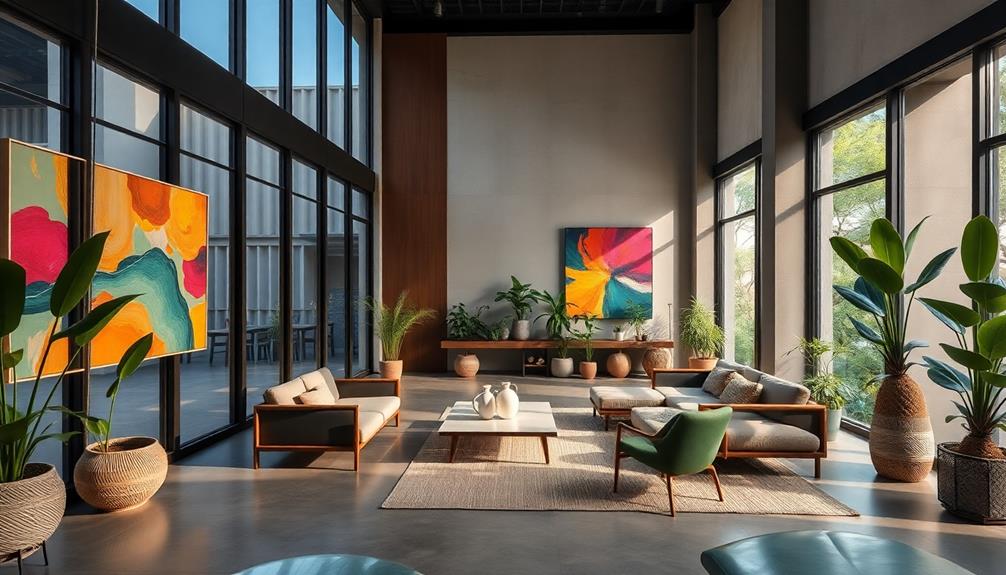
Urban interiors in Indonesia showcase a striking blend of modern design and practicality, reflecting the dynamic lifestyles of city residents. Inspired by modern tropical aesthetics in Bali, urban design often emphasizes creating functional spaces that cater to a fast-paced life.
You'll notice a strong focus on efficiency and aesthetics, making the most of limited living space.
Key characteristics of urban interiors include:
- Modern materials: Use of cement, tiles, and glass for sleek designs.
- Cultural integration: Incorporating traditional fabrics and motifs into contemporary settings.
- Space optimization: Multifunctional furniture and open plan layouts are common to maximize utility.
- Minimalist trends: A preference for simplicity, with neutral palettes and clutter-free environments.
- Technology integration: Smart home features enhance convenience and connectivity for busy lifestyles.
As you explore urban interiors, you'll see how these elements come together to create spaces that aren't only stylish but also incredibly functional, catering to the unique needs of those living in urban areas.
This design approach allows residents to enjoy both modern conveniences and cultural heritage in their everyday lives.
Features of Rural Interiors
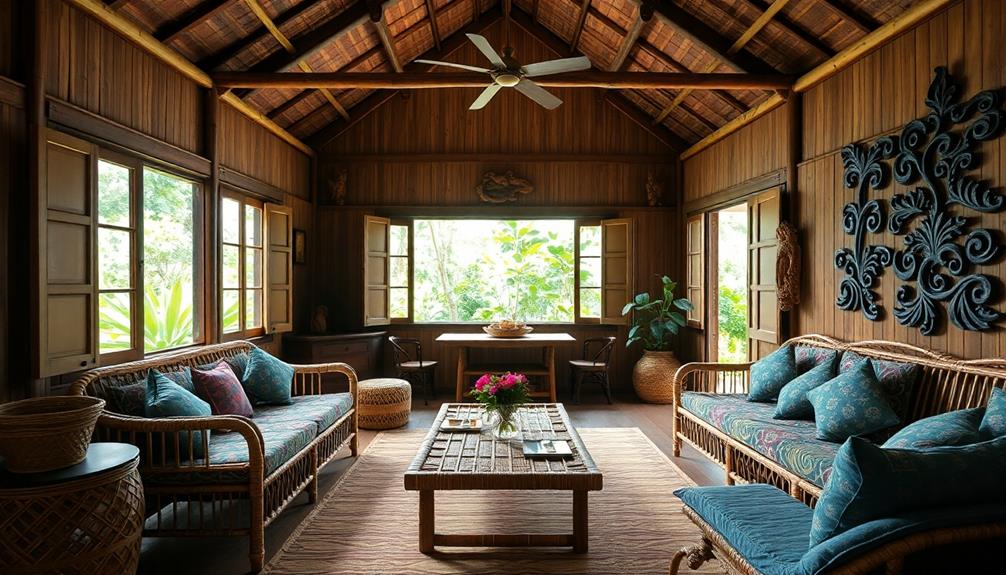
How do rural Indonesian interiors reflect the rich tapestry of local culture and craftsmanship? You'll find that these spaces often showcase traditional materials like woven bamboo matting for walls and raised wooden floors, highlighting the community's craftsmanship. Brightly colored textiles and handcrafted furniture made from local materials enhance the aesthetic appeal, creating a warm and inviting atmosphere.
Rural interiors emphasize open layouts and communal spaces, encouraging family gatherings and social interactions—a reflection of traditional lifestyle practices. Multi-functional furniture maximizes space, allowing families to adapt their homes for various daily activities with ease. You'll notice the presence of local arts and crafts, such as batik and wood carvings, which serve as distinctive elements that celebrate cultural identity.
Here's a quick overview of some key features:
| Feature | Description |
|---|---|
| Materials | Woven bamboo, pounded earth, raised wood |
| Color Palette | Bright textiles and natural hues |
| Layout | Open spaces for communal interaction |
| Furniture | Multi-functional to maximize space |
| Decorative Arts | Batik, wood carvings, and other local crafts |
These elements weave together to create interiors that are both functional and deeply rooted in local heritage.
Material Choices in Design
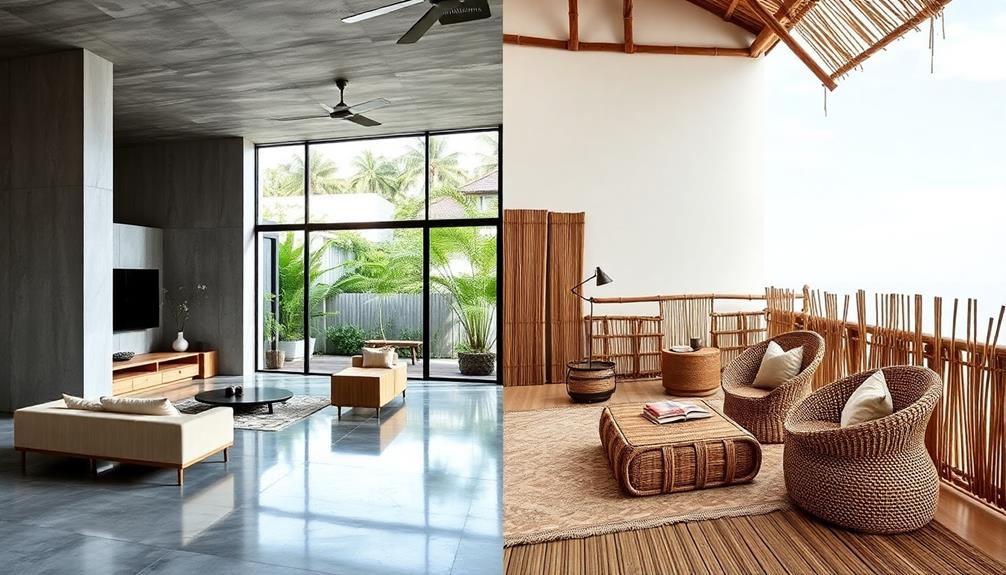
What makes material choices in Indonesian interior design so distinct? The contrast between urban and rural settings reveals a fascinating interplay of tradition and modernity. In urban areas, you'll notice a heavy reliance on modern materials like cement, tiles, and metal, prioritizing functionality and aesthetics.
Conversely, rural interiors embrace traditional materials, particularly woven bamboo, wood, and local textiles, which reflect cultural heritage and craftsmanship. Additionally, rural designs often incorporate natural elements that promote a connection to nature, reflecting the principles of Balinese Interior Design in their material choices.
Here are some key aspects of material choices in Indonesian design:
- Urban designs favor contemporary materials for a sleek look.
- Rural settings celebrate handcrafted items made from locally sourced materials.
- Woven bamboo is a staple in rural designs, showcasing local craftsmanship.
- Sustainable materials like bamboo and rattan are gaining popularity in both domains.
- Urban markets often limit innovation, focusing on rattan and timber for furniture.
These choices not only define the aesthetics of spaces but also convey deeper connections to community values and environmental considerations.
Whether you're drawn to the sleek lines of urban spaces or the rich textures of rural homes, understanding these material choices enhances your appreciation of Indonesian interior design.
The Role of Community
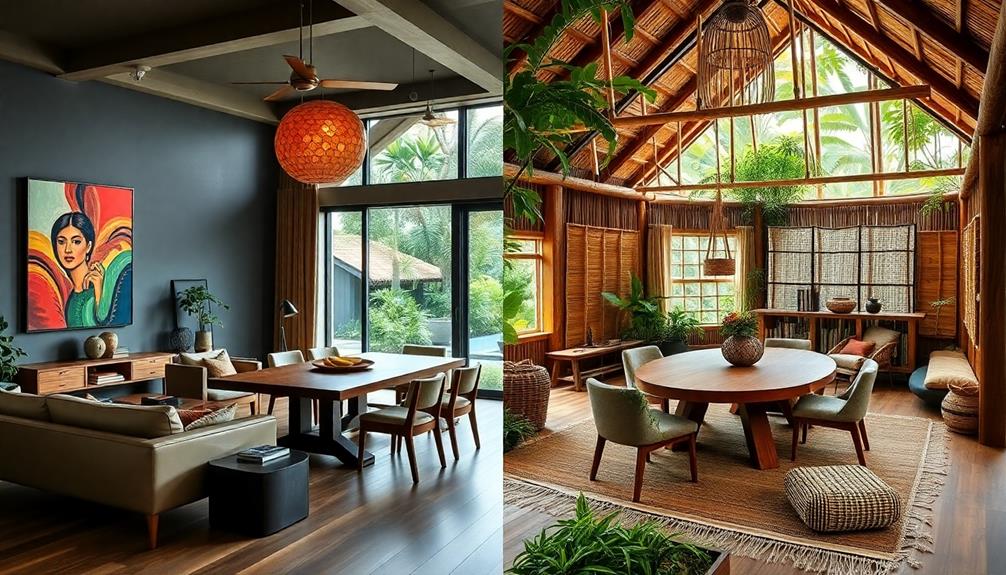
Community plays a significant role in shaping Indonesian interior design, particularly in rural areas where traditional craftsmanship thrives. Here, community involvement fosters a deep connection to cultural heritage and identity. When you engage with local artisans, you open the door to collaborative design approaches that tap into shared knowledge and experiences. This results in customized interior solutions that genuinely reflect your community's needs and preferences.
Incorporating elements like the Face Indonesian Decor Mask can enhance the cultural significance of your space, showcasing the vibrant artistry of local craftspeople.
In contrast, urban design often prioritizes efficiency and modern aesthetics, sometimes sidelining cultural representation and local materials. However, the rise of social media has been a game-changer. It allows rural artisans to showcase their work, enhancing community recognition and appreciation for traditional styles amid urban influences.
Through participatory design processes, you not only enhance the relevance of your interior spaces but also empower your fellow residents. This empowerment promotes self-sustainability and strengthens local economies, ensuring that the artistry of rural Indonesia remains vibrant.
Sustainability in Urban vs. Rural
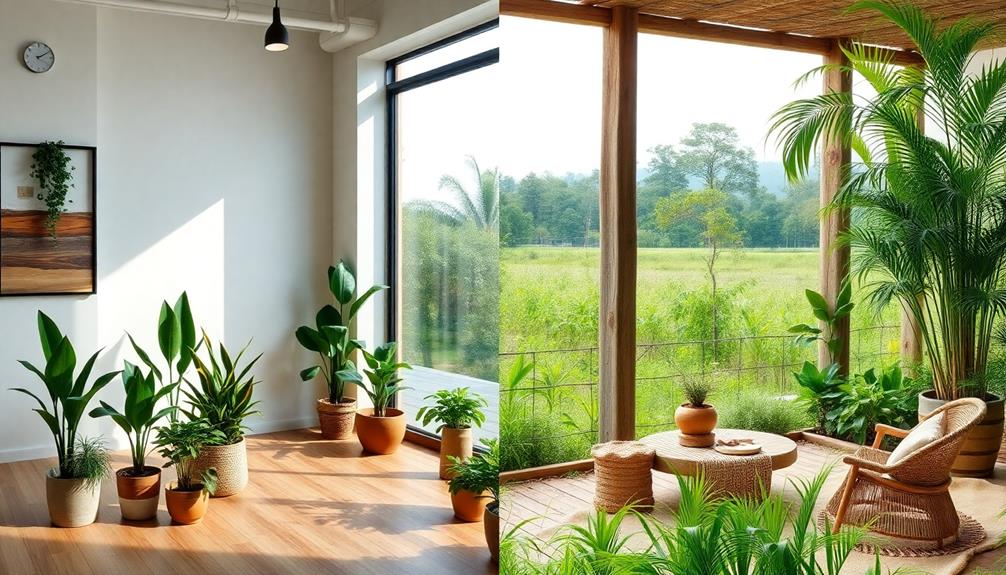
When you look at sustainability in urban and rural Indonesian interior styles, resource availability plays a vital role.
Urban areas often rely on mass-produced materials, while rural designs embrace local resources and craftsmanship.
This is evident in the use of traditional building methods that reflect cultural significance and community values, exemplified by traditional Indonesian housing.
This difference shapes not only design practices but also the level of community involvement in creating sustainable living environments.
Resource Availability Impact
Resource availability plays an essential role in shaping the sustainability of interior design in Indonesia's urban and rural areas.
In urban settings, you'll notice a heavy reliance on modern materials like cement and tiles, driven by their availability and the need for efficiency. However, rural designs often utilize locally sourced materials such as bamboo and wood, highlighting traditional craftsmanship and sustainable practices.
Additionally, urban interiors may incorporate decorative elements like Indonesian decor masks, which serve as unique storytelling pieces, while rural spaces often celebrate local artistry through handmade goods traditional artistry.
When it comes to resource availability, consider the following aspects:
- Urban areas face challenges in sourcing sustainable materials.
- Rural regions benefit from an abundance of natural resources.
- Urban designs often prioritize mass-produced items, leading to a consumption-driven approach.
- Rural interiors foster community with handmade goods.
- Urban environments may overlook sustainability for convenience.
These contrasting approaches not only reflect the immediate needs of each area but also underscore the broader implications of urbanization.
You'll find that while urban interiors increasingly adopt western influences, rural designs remain grounded in local cultural contexts and sustainability.
Ultimately, resource availability shapes not just the materials you see but the very essence of interior design in Indonesia's diverse landscapes.
Design Practices Comparison
Prioritizing modern aesthetics, urban interior design in Indonesia often leans towards efficiency and mass-produced materials, catering to market demands. This approach can overlook sustainable practices, resulting in designs that favor single-use products and self-service solutions.
As you explore urban interiors, you might notice a lack of ecological consideration, contrasting sharply with the rural emphasis on local craftsmanship and sustainability. Urban designs frequently lack the intricate carvings and traditional textiles that characterize traditional Indonesian style home decor, which can enrich the aesthetic and cultural significance of a space.
In rural areas, interior design typically incorporates traditional materials like bamboo and rattan, promoting multifunctionality and longevity. These sustainable practices are deeply rooted in cultural traditions and community needs, ensuring that the designs reflect the local context.
Rural designs prioritize ecological balance, showcasing a profound connection to the environment. While there's a growing awareness of eco-friendly materials in urban settings, this shift often feels like an afterthought rather than a foundational principle.
Urban designs can come across as generic, lacking the community engagement seen in rural practices. By understanding these contrasting approaches, you can appreciate how rural Indonesian interiors inherently foster sustainability, while urban designs are still catching up to the importance of incorporating sustainable practices into their framework.
Community Involvement Importance
Community involvement plays an essential role in shaping sustainable interior design, especially in rural Indonesia. By engaging the community, you can create designs that reflect local culture and practices, resulting in a more meaningful living space. This approach not only honors traditional craftsmanship but also acknowledges the diverse architectural styles that are significant to the community's identity, such as the Rumah Adat.
In contrast, urban areas often focus on efficiency and mass production, which may disregard local preferences.
Here are some benefits of community involvement in rural design:
- Knowledge Sharing: Locals share valuable insights, enhancing customization.
- Cultural Relevance: Designs resonate with the community's heritage and traditions.
- Sustainable Materials: Utilizing local resources promotes environmental responsibility.
- Participatory Approaches: User engagement fosters contextually appropriate solutions.
- Preservation: Traditional craftsmanship is maintained, enriching cultural identity.
Collaborative design methods not only address environmental challenges but also promote self-sustainability.
In rural settings, you can tap into local craftsmanship and materials, creating spaces that are sustainable and culturally significant.
In contrast, urban designs often overlook these aspects, leading to a disconnect from community values.
Historical Context of Housing
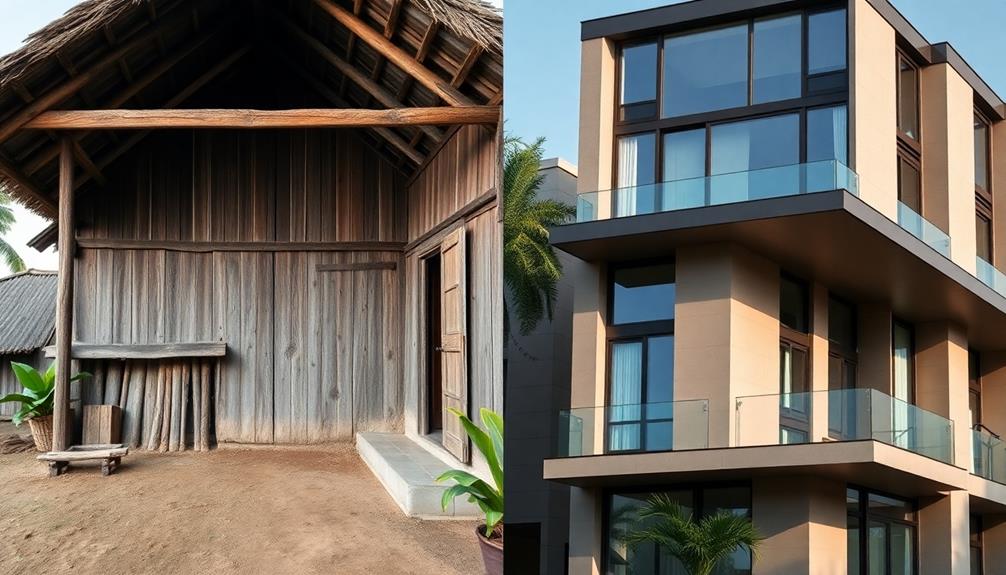
The evolution of housing in Indonesia reveals a striking contrast between urban and rural styles, shaped by historical, cultural, and economic factors.
In rural areas, traditional housing often incorporates materials like pounded earth, concrete, and raised wood floors, reflecting local resources and climate. You'll notice that walls in these regions are usually constructed from woven bamboo matting, providing both insulation and aesthetic appeal. Additionally, the use of vibrant colors and traditional motifs in rural home designs often reflects the local culture, similar to Indonesian Wedding Decor.
Meanwhile, urban housing leans towards more modern materials, utilizing cement or tile floors, with brick and plaster walls that signify a different lifestyle and economic capability.
As migration from rural areas to cities intensified, the demand for urban housing skyrocketed. This rapid urbanization led to housing shortages, resulting in informal settlements that often lack basic amenities.
In contrast to the tranquil settings of rural living, urban conditions can be substandard, with many residents finding themselves in makeshift homes that have become permanent fixtures.
This stark difference in living conditions highlights how historical trends and economic pressures have shaped the housing landscape in Indonesia, making it essential to understand these foundations when exploring interior styles.
Architectural Styles Comparison
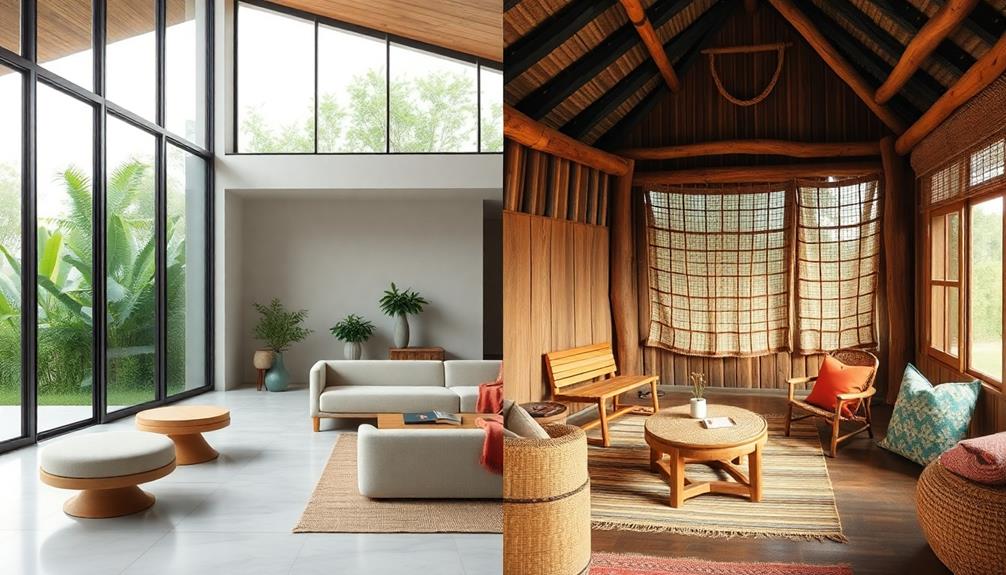
When you compare urban and rural Indonesian architecture, you'll notice distinct differences in materials and construction methods.
Urban designs often showcase modern materials like brick and plaster, while rural homes rely on traditional options like bamboo and mud.
This contrast extends to design aesthetics as well, with urban interiors focusing on functionality and style, whereas rural designs reflect a deeper connection to local culture.
Additionally, rural designs often include elements of tropical architecture that enhance the living experience through open spaces and natural materials, promoting a harmonious relationship with the environment.
Materials and Construction Methods
Urban and rural Indonesian interior styles often showcase a striking contrast in materials and construction methods.
In urban settings, you'll find modern materials like cement, tile, and brick that prioritize functionality and aesthetic appeal. In contrast, rural interiors utilize traditional materials reflecting local customs, such as:
- Woven bamboo matting
- Pounded earth
- Teak or meranti wood for framing
- Dried palm fiber for roofs
- Handcrafted furnishings from local resources
Urban homes typically feature framed structures and mass-produced furnishings, promoting convenience and space efficiency, often resulting in smaller living areas.
Meanwhile, rural houses often have raised wooden floors and larger communal spaces that emphasize family and community-oriented lifestyles.
This architectural diversity highlights how urban environments embrace modern influences, while rural areas maintain traditional craftsmanship.
The materials used in both settings not only affect the aesthetic but also reflect cultural significance and adaptability to local climates.
Understanding these differences can deepen your appreciation for Indonesia's rich architectural tapestry.
Design Aesthetics and Functionality
Aesthetic harmony and practical functionality intertwine in Indonesian interior design, creating a rich tapestry of styles that reflect both urban and rural influences.
In urban settings, design aesthetics often prioritize modernity and efficiency. You'll notice the use of materials like cement and tile, which cater to contemporary lifestyles but can sometimes sacrifice warmth and uniqueness. The urban environment embraces mass production, which leads to sleek, single-use products lacking the personal touch.
In contrast, rural interiors celebrate traditional craftsmanship, focusing on local materials such as woven bamboo and pounded earth. Here, the design aesthetics reflect cultural heritage and local customs, displaying artisanal techniques and unique imperfections that tell a story.
These rural designs often emerge from collaborative efforts, ensuring sustainability and customization in every piece.
While the migration from rural to urban areas has led to a blending of styles, urban interiors often miss the handcrafted quality that characterizes rural spaces. You'll find that rural interiors maintain a deeper connection to traditions and rituals, lending a rich, personal touch that urban designs sometimes lack.
Ultimately, both styles offer valuable insights into functionality and aesthetic choices in Indonesian interior design.
Future Trends in Indonesian Design
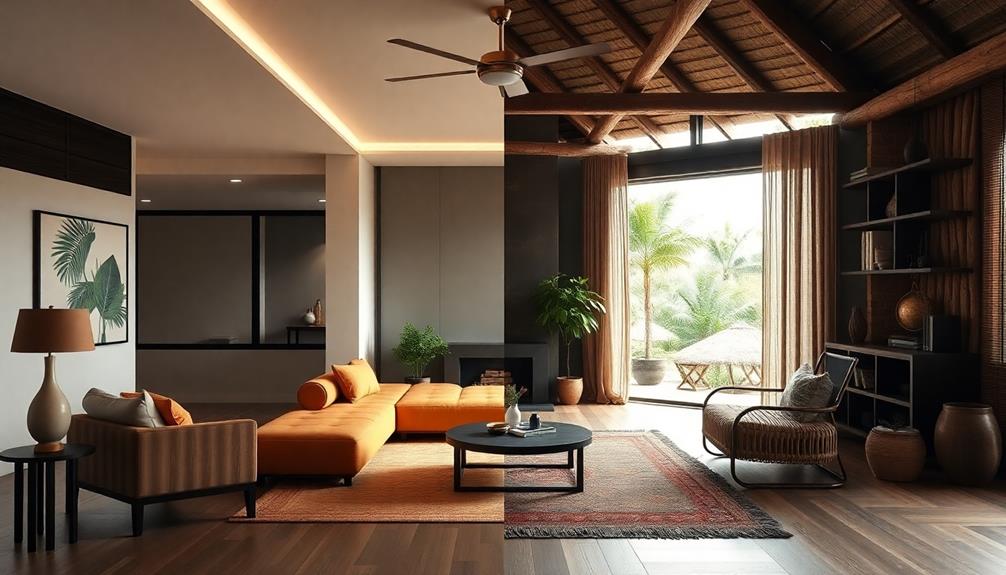
Emphasizing sustainability, future trends in Indonesian design reflect a strong commitment to eco-friendly materials and practices.
You'll notice a growing focus on integrating local cultural elements into contemporary designs, allowing for a deeper connection to Indonesian heritage.
Minimalist and functional aesthetics are becoming the go-to choice for younger generations, especially in urban spaces where efficiency is key.
Here are some emerging trends you might find interesting:
- Eco-friendly Materials: Bamboo, reclaimed wood, and organic textiles are in high demand.
- Cultural Integration: Designs that incorporate traditional motifs and craftsmanship to enhance authenticity.
- Minimalism: Simplified forms and decluttered spaces are prioritized for modern living.
- Community Events: Events like Pasar Papringan promote innovative design approaches and local artisans.
- Social Media Influence: Platforms like Instagram are essential for emerging designers to showcase their work and collaborate.
As you explore these trends, you'll see how sustainability isn't just a buzzword but a significant principle driving the future of Indonesian design.
The blend of tradition and modernity creates a unique interior experience that resonates with both urban and rural audiences.
Frequently Asked Questions
How Do Urban and Rural Communities Compare and Contrast?
When you compare urban and rural communities, you'll notice urban areas emphasize modernity and convenience, while rural settings prioritize tradition and connection to nature. Each offers unique lifestyles shaped by their environments and cultural values.
What Are the Differences Between Urban and Rural Setting?
In urban settings, you'll find fast-paced lifestyles, modern conveniences, and standardized designs. In contrast, rural environments offer slower rhythms, rich traditions, and unique, personalized spaces, emphasizing community, sustainability, and cultural heritage in everyday life.
What Differences Exist Between Urban and Rural Lifestyles?
Urban lifestyles emphasize speed, convenience, and modernity, while rural lifestyles focus on tradition, community, and sustainability. You'll find urban areas bustling with activity, contrasting with the slower, nature-connected pace of rural life.
What Are the Rural Urban Differences in Adult Life Expectancy in Indonesia?
You might assume urban areas guarantee longer life, but it's true: urban Indonesians live about five years longer than their rural counterparts. Access to healthcare and better resources profoundly influences this difference in life expectancy.
Conclusion
To sum up, exploring the contrasting styles of urban and rural Indonesian interiors reveals a rich tapestry of cultural influences and community values. Just like the vibrant colors of a traditional batik, each design reflects its unique environment and history. As you appreciate these differences, consider how future trends might blend the best of both worlds, creating spaces that honor tradition while embracing innovation. Ultimately, understanding these styles deepens your appreciation for Indonesia's diverse architectural landscape.
